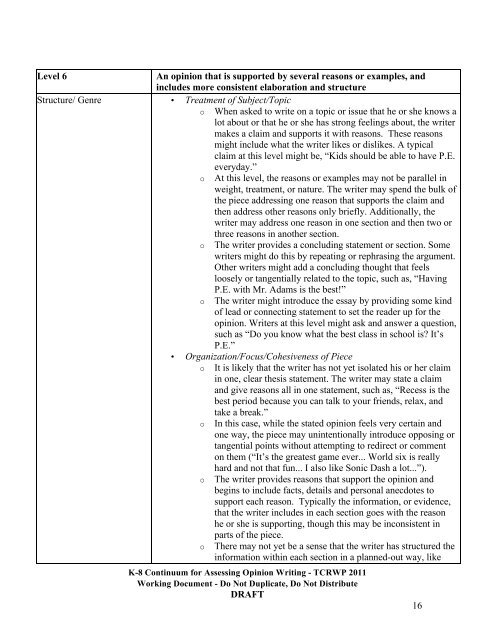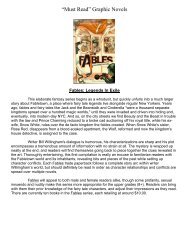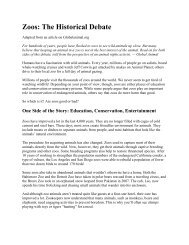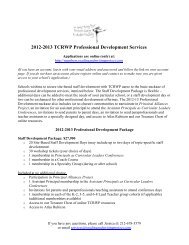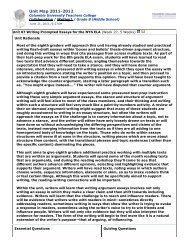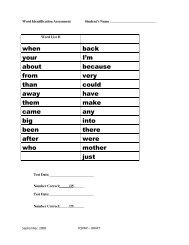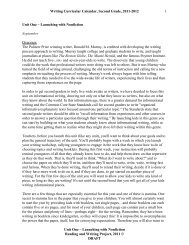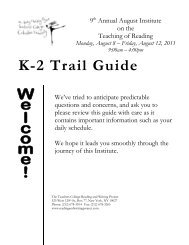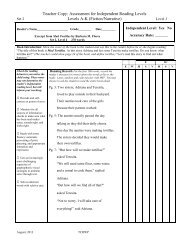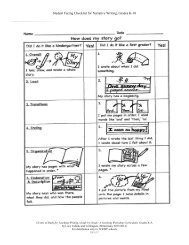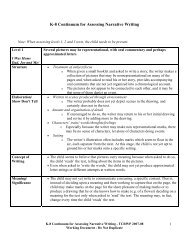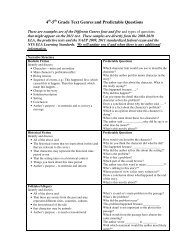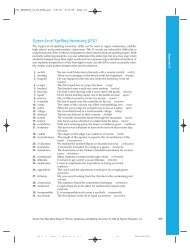Continuum for Assessing Opinion/Argument Writing - The Reading ...
Continuum for Assessing Opinion/Argument Writing - The Reading ...
Continuum for Assessing Opinion/Argument Writing - The Reading ...
Create successful ePaper yourself
Turn your PDF publications into a flip-book with our unique Google optimized e-Paper software.
Level 6<br />
An opinion that is supported by several reasons or examples, and<br />
includes more consistent elaboration and structure<br />
Structure/ Genre • Treatment of Subject/Topic<br />
o When asked to write on a topic or issue that he or she knows a<br />
lot about or that he or she has strong feelings about, the writer<br />
makes a claim and supports it with reasons. <strong>The</strong>se reasons<br />
might include what the writer likes or dislikes. A typical<br />
claim at this level might be, “Kids should be able to have P.E.<br />
everyday.”<br />
o At this level, the reasons or examples may not be parallel in<br />
weight, treatment, or nature. <strong>The</strong> writer may spend the bulk of<br />
the piece addressing one reason that supports the claim and<br />
then address other reasons only briefly. Additionally, the<br />
writer may address one reason in one section and then two or<br />
three reasons in another section.<br />
o <strong>The</strong> writer provides a concluding statement or section. Some<br />
writers might do this by repeating or rephrasing the argument.<br />
Other writers might add a concluding thought that feels<br />
loosely or tangentially related to the topic, such as, “Having<br />
o<br />
P.E. with Mr. Adams is the best!”<br />
<strong>The</strong> writer might introduce the essay by providing some kind<br />
of lead or connecting statement to set the reader up <strong>for</strong> the<br />
opinion. Writers at this level might ask and answer a question,<br />
such as “Do you know what the best class in school is It’s<br />
P.E.”<br />
• Organization/Focus/Cohesiveness of Piece<br />
o It is likely that the writer has not yet isolated his or her claim<br />
in one, clear thesis statement. <strong>The</strong> writer may state a claim<br />
and give reasons all in one statement, such as, “Recess is the<br />
best period because you can talk to your friends, relax, and<br />
take a break.”<br />
o<br />
o<br />
o<br />
In this case, while the stated opinion feels very certain and<br />
one way, the piece may unintentionally introduce opposing or<br />
tangential points without attempting to redirect or comment<br />
on them (“It’s the greatest game ever... World six is really<br />
hard and not that fun... I also like Sonic Dash a lot...”).<br />
<strong>The</strong> writer provides reasons that support the opinion and<br />
begins to include facts, details and personal anecdotes to<br />
support each reason. Typically the in<strong>for</strong>mation, or evidence,<br />
that the writer includes in each section goes with the reason<br />
he or she is supporting, though this may be inconsistent in<br />
parts of the piece.<br />
<strong>The</strong>re may not yet be a sense that the writer has structured the<br />
in<strong>for</strong>mation within each section in a planned-out way, like<br />
K-8 <strong>Continuum</strong> <strong>for</strong> <strong>Assessing</strong> <strong>Opinion</strong> <strong>Writing</strong> - TCRWP 2011<br />
Working Document - Do Not Duplicate, Do Not Distribute<br />
DRAFT<br />
16


